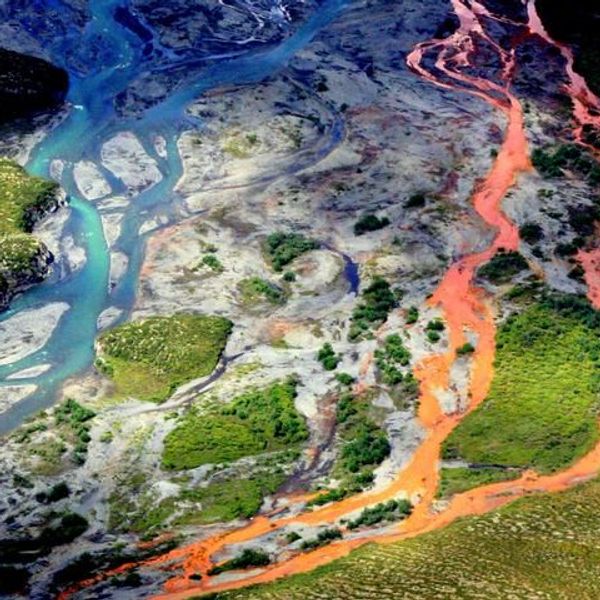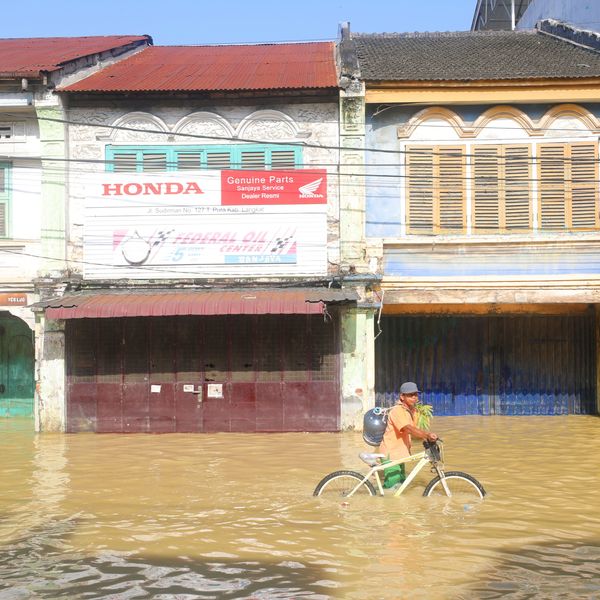
The Zackenberg valley in Northeast Greenland, summer 2018. Huge amounts of snow still covered the ground in late June, where the snow-covered season usually is coming to an end. (Photo: Lars Holst Hansen)
In Twist of Climate Crisis, Study Finds Extreme Arctic Snowfall in 2018 Caused Near 'Complete Reproductive Failure of Plants and Animals'
"2018 may offer a peep into the future, where increased climatic variability may push the arctic species to—and potentially beyond—their limits."
A new study published Tuesday looked at the implications of extreme snowfall in the Arctic in 2018--the kind of increased precipitation event scientists link to climate change--and researchers say the scenario could be a harbinger of how ecosystems in the region will be negatively affected by a rapidly warming planet.
"The result was an almost complete reproductive failure of plants and animals of all sizes," the authors wrote.
The takeaway for arctic ecosystems, the authors found, is that "changes in precipitation may prove as crucial as changes in temperature--if not even more."
For the study, published in the journal PLOS Biology, researchers focused on the monitoring site of Zackenberg in Northeast Greenland. In 2018, the Arctic--including the High Arctic where the Zackenberg facility is--saw unusually large amounts of snow. That meant there was a significant delay in snow melt, which in turn made it difficult for plants to grow and for animals to access resources.
The result? The "most complete reproductive failure encountered in the terrestrial ecosystem during more than two decades of monitoring," said the study.
In plants, because flowering happened later, seeds were unable to set before frost came. The abundance of migratory shorebirds was also low. The birds made nests late, so the eggs that hatched did so late. As such, the young birds had insufficient time to develop ahead of their migration.
"The severity of the 2018 conditions were evidenced not only by the near-complete lack of breeding amongst shorebirds," noted the researchers, "but also by five shorebirds found starved to death in 2018--a phenomenon never encountered before."
Among the mammals that took a hit as a result of the extreme snowfall were the Arctic fox--no cubs were observed--and muskox--almost no calves were observed.
"One non-breeding year is hardly that bad for high-arctic species," explained lead author Niels Martin Schmidt of Denmark's Aarhus University.
"The worrying perspective," he continued, "is that 2018 may offer a peep into the future, where increased climatic variability may push the arctic species to--and potentially beyond--their limits. Our study shows that climate change is more than 'just' warming, and that ecosystems may be hard hit by currently still rare but extreme events."
"Only by keeping an eye on full arctic ecosystems," said Schmidt, "can we understand the havoc brought by the changing climate."
An Urgent Message From Our Co-Founder
Dear Common Dreams reader, The U.S. is on a fast track to authoritarianism like nothing I've ever seen. Meanwhile, corporate news outlets are utterly capitulating to Trump, twisting their coverage to avoid drawing his ire while lining up to stuff cash in his pockets. That's why I believe that Common Dreams is doing the best and most consequential reporting that we've ever done. Our small but mighty team is a progressive reporting powerhouse, covering the news every day that the corporate media never will. Our mission has always been simple: To inform. To inspire. And to ignite change for the common good. Now here's the key piece that I want all our readers to understand: None of this would be possible without your financial support. That's not just some fundraising cliche. It's the absolute and literal truth. We don't accept corporate advertising and never will. We don't have a paywall because we don't think people should be blocked from critical news based on their ability to pay. Everything we do is funded by the donations of readers like you. Will you donate now to help power the nonprofit, independent reporting of Common Dreams? Thank you for being a vital member of our community. Together, we can keep independent journalism alive when it’s needed most. - Craig Brown, Co-founder |
A new study published Tuesday looked at the implications of extreme snowfall in the Arctic in 2018--the kind of increased precipitation event scientists link to climate change--and researchers say the scenario could be a harbinger of how ecosystems in the region will be negatively affected by a rapidly warming planet.
"The result was an almost complete reproductive failure of plants and animals of all sizes," the authors wrote.
The takeaway for arctic ecosystems, the authors found, is that "changes in precipitation may prove as crucial as changes in temperature--if not even more."
For the study, published in the journal PLOS Biology, researchers focused on the monitoring site of Zackenberg in Northeast Greenland. In 2018, the Arctic--including the High Arctic where the Zackenberg facility is--saw unusually large amounts of snow. That meant there was a significant delay in snow melt, which in turn made it difficult for plants to grow and for animals to access resources.
The result? The "most complete reproductive failure encountered in the terrestrial ecosystem during more than two decades of monitoring," said the study.
In plants, because flowering happened later, seeds were unable to set before frost came. The abundance of migratory shorebirds was also low. The birds made nests late, so the eggs that hatched did so late. As such, the young birds had insufficient time to develop ahead of their migration.
"The severity of the 2018 conditions were evidenced not only by the near-complete lack of breeding amongst shorebirds," noted the researchers, "but also by five shorebirds found starved to death in 2018--a phenomenon never encountered before."
Among the mammals that took a hit as a result of the extreme snowfall were the Arctic fox--no cubs were observed--and muskox--almost no calves were observed.
"One non-breeding year is hardly that bad for high-arctic species," explained lead author Niels Martin Schmidt of Denmark's Aarhus University.
"The worrying perspective," he continued, "is that 2018 may offer a peep into the future, where increased climatic variability may push the arctic species to--and potentially beyond--their limits. Our study shows that climate change is more than 'just' warming, and that ecosystems may be hard hit by currently still rare but extreme events."
"Only by keeping an eye on full arctic ecosystems," said Schmidt, "can we understand the havoc brought by the changing climate."
A new study published Tuesday looked at the implications of extreme snowfall in the Arctic in 2018--the kind of increased precipitation event scientists link to climate change--and researchers say the scenario could be a harbinger of how ecosystems in the region will be negatively affected by a rapidly warming planet.
"The result was an almost complete reproductive failure of plants and animals of all sizes," the authors wrote.
The takeaway for arctic ecosystems, the authors found, is that "changes in precipitation may prove as crucial as changes in temperature--if not even more."
For the study, published in the journal PLOS Biology, researchers focused on the monitoring site of Zackenberg in Northeast Greenland. In 2018, the Arctic--including the High Arctic where the Zackenberg facility is--saw unusually large amounts of snow. That meant there was a significant delay in snow melt, which in turn made it difficult for plants to grow and for animals to access resources.
The result? The "most complete reproductive failure encountered in the terrestrial ecosystem during more than two decades of monitoring," said the study.
In plants, because flowering happened later, seeds were unable to set before frost came. The abundance of migratory shorebirds was also low. The birds made nests late, so the eggs that hatched did so late. As such, the young birds had insufficient time to develop ahead of their migration.
"The severity of the 2018 conditions were evidenced not only by the near-complete lack of breeding amongst shorebirds," noted the researchers, "but also by five shorebirds found starved to death in 2018--a phenomenon never encountered before."
Among the mammals that took a hit as a result of the extreme snowfall were the Arctic fox--no cubs were observed--and muskox--almost no calves were observed.
"One non-breeding year is hardly that bad for high-arctic species," explained lead author Niels Martin Schmidt of Denmark's Aarhus University.
"The worrying perspective," he continued, "is that 2018 may offer a peep into the future, where increased climatic variability may push the arctic species to--and potentially beyond--their limits. Our study shows that climate change is more than 'just' warming, and that ecosystems may be hard hit by currently still rare but extreme events."
"Only by keeping an eye on full arctic ecosystems," said Schmidt, "can we understand the havoc brought by the changing climate."

